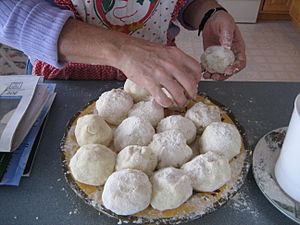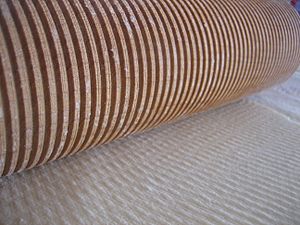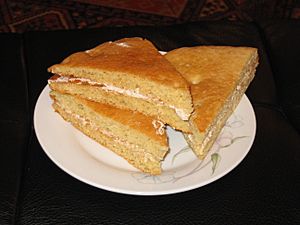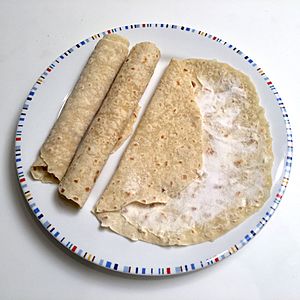Lefse facts for kids
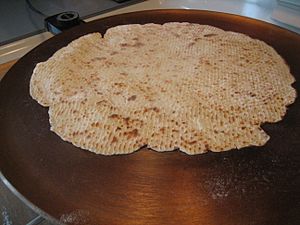
Lefse on a griddle
|
|
| Type | Flatbread |
|---|---|
| Place of origin | Norway |
| Main ingredients | Traditional: potato flour Variations: milk or cream, flour |
Lefse is a soft, traditional flatbread from Norway. It's usually made with potatoes, flour, butter, and milk or cream. People cook it on a large, flat griddle. Special tools help make lefse. These include long wooden sticks for turning and rolling pins with deep grooves.

Contents
Tasty Toppings for Lefse

There are many yummy ways to enjoy lefse. The most common way is to spread butter on it and roll it up. In Norway, this is called "lefse-klenning."
You can also add cinnamon and sugar. Some people spread jelly, lingonberries, or a special Norwegian spread called gomme.
In America, people sometimes roll lefse with peanut butter and sugar. Other sweet options include butter with white or brown sugar, or butter with corn syrup. You can even try butter and salt.
Lefse can be savory too! People eat it with ham and eggs, beef, or other meats like Ribberull and mustard. It's a bit like a tortilla. Lefse is also often served with lutefisk, a traditional fish dish. The fish is often rolled right inside the lefse.
Different Kinds of Lefse
Lefse can be made and eaten differently across Norway. It usually looks like a flatbread. But in some parts of Norway, like Valdres, it's much thinner.
Tynnlefse: Thin & Sweet
Tynnlefse means "thin lefse." It's made in central Norway. People roll it up with butter, sugar, and cinnamon. Sometimes they use butter and brown sugar instead.
Tjukklefse: Thick & Cake-like
Tjukklefse or tykklefse is a thicker kind of lefse. It's often served with coffee, almost like a cake.
Potetlefse: Made with Potatoes
Potetlefse is "potato lefse." It's similar to tynnlefse but made with potatoes.
Lompe: Hot Dog's Best Friend
Lompe or potetkake is like a smaller version of potato lefse. It's usually made with just boiled potatoes, flour, and salt. Lompe is often used instead of a hot dog bun. You can roll up sausages in it. This is called pølse med lompe in Norway. It's very popular on Norway's Constitution Day on May 17. People add toppings like ketchup and mustard. Some also add raw onions or other relishes.
Møsbrømlefse: Cheesy Delight
Møsbrømlefse is a special kind from the Salten area in North Norway. It has a warm, thick sauce called møsbrømmen. This sauce is made from cheese, water, and flour. It's spread on cooled lefse, and then butter is added.
Nordlandslefse: Fishermen's Treat
Nordlandslefse is a small, chunky lefse. It's made with butter, syrup, sugar, eggs, and flour. It was first made in western Norway as a treat for fishermen.
Anislefse: A Hint of Anise
Anislefse comes from the coast of Hordaland. It's a bit thicker than thin lefse. It gets its special flavor from lots of whole aniseed.
Hardangerlefse: A Crispy Kind
Another type is Hardangerlefse, from Hardanger in Norway. It's made with Graham flour or whole wheat flour and yeast. It often uses egg yolks and buttermilk instead of potatoes.
The dough is rolled very thin. Then, a special grooved rolling pin cuts a grid pattern into it. This stops air pockets from forming when it cooks. It also helps roll the lefse even thinner. Hardangerlefse is cooked at a high temperature (about 205 °C or 400 °F) until it's browned. Then, it's left to dry. It can even be freeze-dried to store it longer.
Dried Hardangerlefse can last for six months or more without a fridge, as long as it stays dry. People believe this bread was a main food for sailors, even back in Viking times.
To eat dried Hardangerlefse, you dip it in water. Then you place it in a damp towel. Many people say using salted water or seawater makes it taste even better. The dry lefse becomes soft again in about an hour. This gives you time to prepare fillings like eggs or herring to wrap inside.
Lefse in the United States
Holiday Traditions
Lefse is a popular Scandinavian treat, especially around the Christmas holidays. Many Scandinavian-Americans enjoy lefse mostly during Thanksgiving and Christmas.
A Bit of History
When people in the United States talk about "lefse," they usually mean potato lefse. This is because Norwegian immigrants often had good potato crops. So, potato lefse became more common in America than other types.
Norwegian immigrants brought folded lefse with them on their long ship journeys to America. Later, during World War I, Americans were asked to eat more potatoes to save wheat for soldiers. This made lefse even more popular for Norwegian Americans.
Today, lefse is not an everyday food in Norway. But Norwegian Americans often make it a special part of their dinners.
Keeping the Tradition Alive
- Families often make lefse together. It's a fun holiday activity. This also helps younger generations learn how to make it.
- Groups like the Sons of Norway teach young people how to make lefse. A group in Vancouver, Washington, uses a lot of potatoes to make lefse every month!
- Some expert lefse makers can roll 85 to 100 pieces of lefse in an hour. Some can even make up to 140!
Where to Find Lefse
In Norway, many families buy their lefse instead of making it. In the United States, making lefse at Christmas is a tradition. But more families are buying it from stores too. For example, a store in Minneapolis, Minnesota, sells about $80,000 worth of lefse each Christmas.
You can find lefse in many grocery stores in Midwestern states. These include Minnesota, North Dakota, South Dakota, Iowa, Wisconsin, Oregon, Alaska, and Washington. One factory in Rushford, Minnesota, makes about half a million rounds of lefse every year!
Small lefse factories are found in many Norwegian communities in this area. In bigger towns, you can find lefse in grocery stores all year. Many Scandinavian festivals in the U.S. also sell lefse. You can even order it online.
World's Biggest Lefse
The town of Starbuck, Minnesota, made the world's largest lefse. It was created on July 1, 1983.
Lefse Celebrations
Cities and towns with many Scandinavian people celebrate lefse.
- Fargo, North Dakota, has a popular Lutefisk and Lefse Festival every August.
- Fosston, Minnesota, hosts a Lefse Fest in November. Makers compete for the "Champion Lefse Maker" title.
- In Mankato, Minnesota, people celebrate "Lefse Day" on the Sunday after Thanksgiving. It's a day for cooking lefse.
- The Potato Days festival in Barnesville, Minnesota, has been held since the 1930s. This festival also hosts the National Lefse Cookoff.
Fun Facts and Jokes
Some Norwegian Americans used to say that Vikings made and ate lefse. But this isn't true! Potatoes didn't come to Norway until long after the Viking Age.
People also tell funny stories about lefse. One joke says lefse is "so tasteless that many mistakenly eat the paper doily under the stack and do not know the difference." Of course, many people really love lefse!
New Ways to Enjoy Lefse
Sometimes, Norwegian foods are mixed with other types of food. You could use lefse instead of tortillas to make enchiladas! American lefse is sometimes served with butter, cinnamon sugar, or lingonberry jelly. Then it's rolled up and eaten like a crêpe. You can also add eggs, sausage, and cheese to make a breakfast burrito. Or, you can roll up Smørrebrød (open-faced sandwiches) in your lefse.
See also
 In Spanish: Lefse para niños
In Spanish: Lefse para niños


